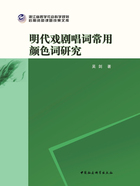
ABSTRACT
Color is a natural phenomenon,the perception of which exists in people's brain,meanwhile the expression of which is a mixed product of both language and culture.Now the study of color words has been a classic research area of general lexicology.
The color words in Chinese are the collective vocabulary which Chinese people use to express color category.The total number,word formation,syntactic characteristics,collocation competence,semantic system description and semantic evolution analysis in Chinese color words,all of which are an integral part of Chinese vocabulary study.Chinese classic verse language has been literally processed on the basis of natural language,not only should accord with verse language's literary standard,but only should reflect the general rules of everyday language usage.This paper analyze color words’ semantic system,syntactic functions and pragmatic features in Chinese verse in order to provide a case study for color words’ systematic research in Chinese.
The color words in Chinese verse's literary language deserves further study.The opera lyrics in Ming Dynasty belong to Chinese classic verse language,the Ming opera authors and works are many times than the Yuan opera,especially there has been a world-famous dramatist Tang Xianzu in Ming Dynasty,who is like Shakespare in Britain.Opera(especially chuanqi)has gradually become the representative literary genre in Ming Dynasty literature.This paper named The Study of Commonly Used Color Words in Ming Dynasty's Opera Lyrics is an indispensible part of Chinese poetry language study in separate ages.This paper carefully choose 74 opera works(about 2.94 million words)as the source of corpus including chuanqi and zaju.This paper finally get 6323 example sentences as our corpus sources and build the corpus.According to color property,This paper divide seven categories“white,black,red,green,yellow,blue,macro-color”and include all color words from the corpus into the seven categories.From the perspective of phonetic form,there are monosyllable,double syllable and tri-syllable color words.From the perspective of combination of morphemes,there are compound,attachment and reduplication of color words.From the perspective of semantic collocation,This paper divide all color word into three domains:natural objects(9 subclasses),non-natural objects(14 subclasses)and human body(10 subclasses).
This paper determines the prototype color words of six major categories“bai,hei,hong,cui,huang,cui,and qing”except the general category,meanwhile it determines eight commonly used color words“bai,hei,hong,zi,lü,cui,huang and qing”.This paper summarizes semantic systems of these eight commonly used color words(“bai”has 11 senses,“hei”has 7 senses,“hong”has 10 senses,“zi”has 4 senses,“lü”has 6 senses,“cui”has 11 senses,“huang”has 6 senses,“qing”has 11 sense).Based on the calculated frequency of these eight commonly used color words,this paper gets the semantic saliency degree.Based on the number of these eight commonly used color words at each collocation sub-class,this paper gets semantic generalization degree.Based on these eight commonly used color words’ most significant sense as prototypical meaning,they can get other non-prototypical meaning through metonymy,metaphor and social culture mechanism.The semantic system of“qing”is very complex,which has six color senses“green-blue,fresh green,blue,black-green,green-white,blue-purple”,the difference is determined by the collocation property.Each of these eight commonly used color words has its own most generalization degree sub-class collocation:bai for weather words,hei for weather words,hong for plant words,zi for clothing words,lü for plant words,cui for clothing and face words,huang for mountains and rivers words,qing for animal words).The combination of“color words plus color words”has strong motivations.
This paper investigate these eight commonly used color words from three perspectives of parallel structure,parallelism and ABB type color words wholly,meanwhile it also investigate these eight commonly used color words in“linchuan four dreams”(especially Peony Pavilion)wrote by the most famous playwright Tang Xianzu in Ming dynasty as a case study based on theme,role and rhythm.In the color words parallel structures,hong has the highest frequency,qing has the most abundant cases,hei never has parallel structures with“green”category.The parallelism with only one color word can reflex the most significant color effect.The parallelism with different color words,these words should be easily collinear in the natural and social surroundings where Han ethnic group has long term survival.ABB color word is the most conspicuous words,not only because it is always place in the sentence first or other significant position,but only because it has strong rhythm and rich semantic expressions.Different themes,roles and rhythm criterion lead to different usages of color words.
According to whether the color word(morpheme)is involved in the process of the semanticunity construction,color-related words can be divided into two kinds:one with color,the other one without color.The first kind of color-related words is quite simple in semantics,which mean“something with some color”.The second kind of color-related words is quite complex in semantics,which need to be decided in specific context.From a pragmatic perspective,during the selection of“the same color word + different noun”and“different color word + the same noun”,it can reflect the author's emotional tendency and writing skills.The color-related words with creative use of color words would be more elegant and amazing.The color-related words contain rich cultural connotation,which can help us to understand Han ethnic group's culture and aesthetic point.This paper suggests that it would be better to discover more semantic,pragmatic and cultural characteristics in color-related words based on the interpretation of traditional Chinese linguistics.
KEY WORDS:color words;semantic system;semantic saliency;semantic generalization;pragmatic analysis;color-related words